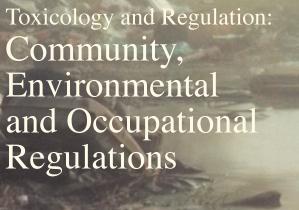Community |
||
Environmental |
||
Occupational |
||
Superfund Listings and Delistings: recent sites added for superfund remediation, based on threat to human health; those cleaned-up sites that have been delisted. |
||
TLV, TWA, REL, PEL, STEL, Ceiling Limits, EEL, STPL, SPEL, CEL, IDLH, ERPG, LOAEL, NOAEL, TD50, LD50. What these standards mean, how they are determined and how they are used; comparison between standards--how safety and hazard levels vary from one standard to another for same chemical. |
||
Agencies and the regulations that control some aspect of chemical exposure--in water, air, food, hazardous waste sites, soil, consumer goods, community or industrial settings. A guide and map as to who does what and how the different agencies and regulations coordinate, overlap or contradict one another. |
||

Regulation

Endocrine Disrupting Chemicals: Implications for setting threshold values for 'safe' exposure to toxics. How these levels are set; types of toxicity testing used. Role of LD50 [lethal dose 50%], LOAEL [Lowest Observed Adverse Effect Level], and short term toxicity testing. Are these adequate with more sensitive measurements of toxicity and recent findings?
Mold, Moisture & Remediation: ACGIH Workshop, September 19-22, 2005, Cincinnati, Ohio
Air Quality Index for Particle Pollution: general categories and risks to sensitive sub populations; real time index: http://epa.gov/airnow
EPA Guidelines for Carcinogen Risk Assessment and Supplemental Guidance for Assessing Susceptibility from Early-Life Exposure to Carcinogens. http://www.epa.gov/cancerguidelines
FDA-EPA Advisory on Mercury and Fish Consumption: Why FDA/EPA maintained different standards for so long, the scientific basis, and what they have agreed to in joint advisory: what this joint statement says and doesn't say, and what it means and (doesn't mean). Distinctions between policy and science.
Material Safety Data Sheets (MSDS) and the information they are required to provide: how complete, how accurate,how scientific? Coordination with warning information of the Consumer Product Safety Commission (CPSC). Retailer's responsibilities and what the consumer is supposed to follow.
Exposure assessment and air modeling: EPA-approved air models; what they are approved to do and what they cannot do. Scientific basis for air models in acute chemical releases--error rates and general acceptance in the peer-reviewed scientific literature. Do they stand up to the Daubert?
American Conference of Governmental Industrial Hygienists (ACGIH) and its Threshhold Limit Value (TLV): use by governments around the world, how TLVs are determined--science versus cost benefit analysis--and limitations in 'safety' analysis. Uses and misuses in hazard
